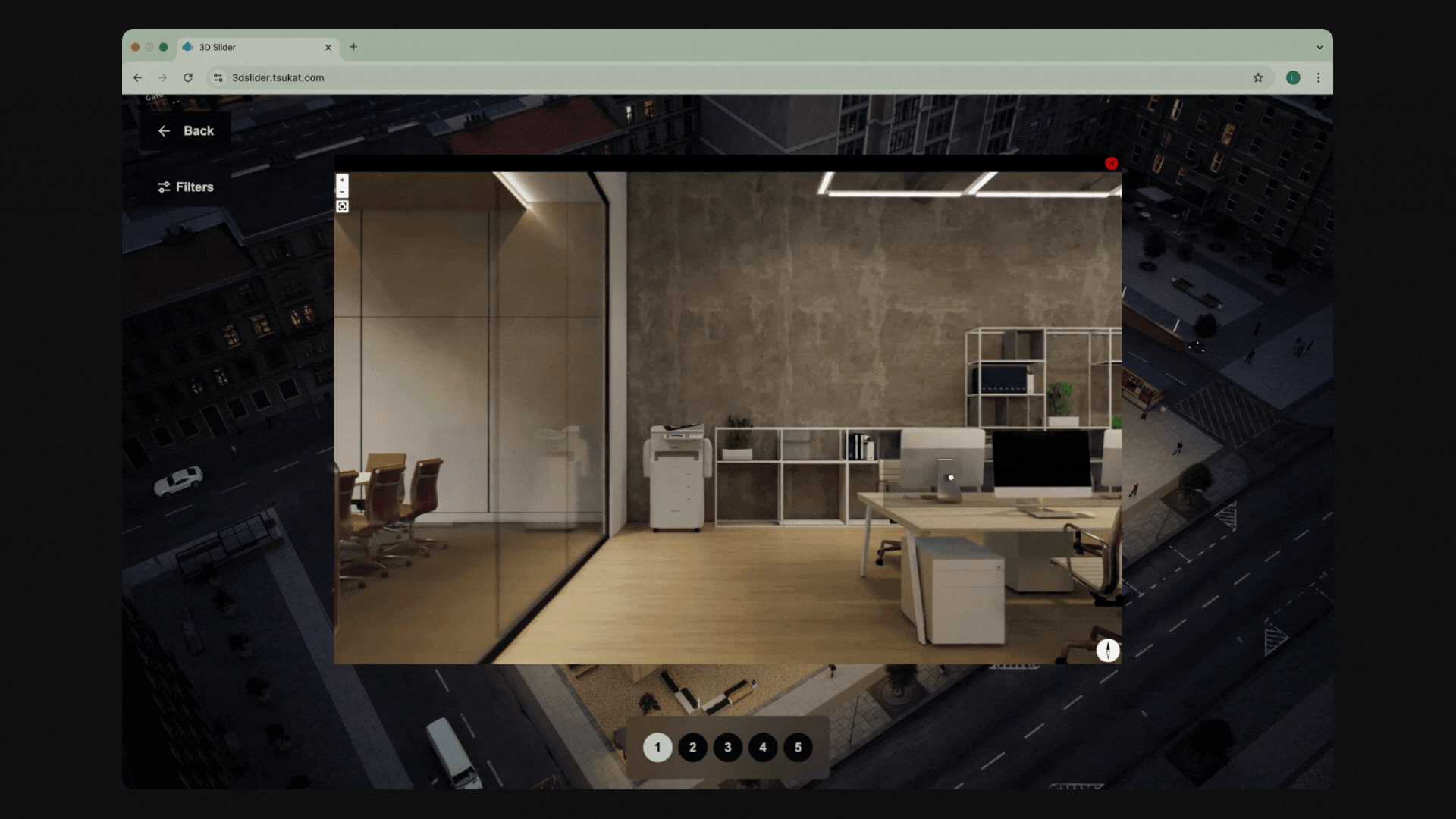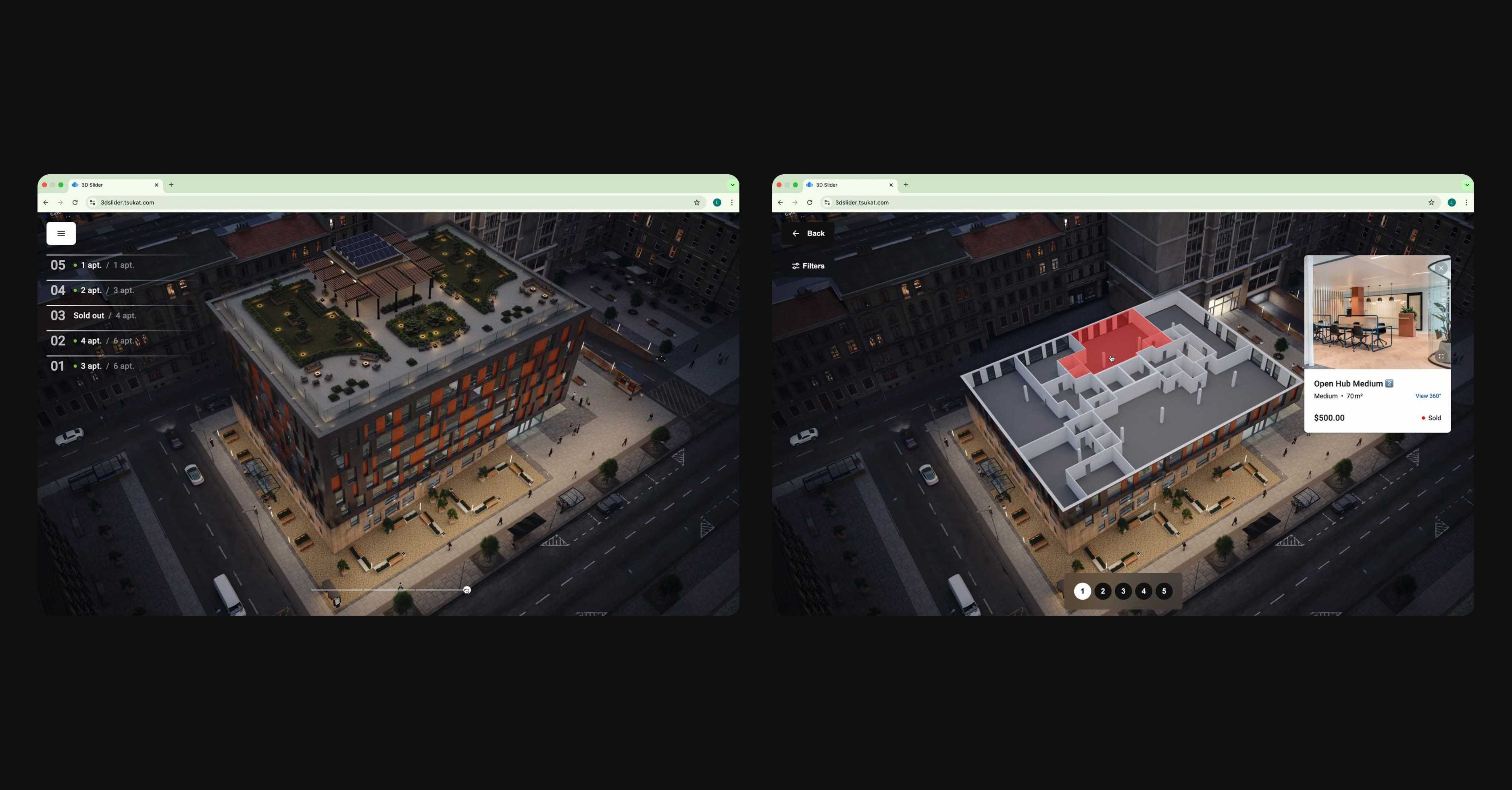Interactive Real Estate Presentation:
Web Viewer

Real estate is one of the industries with the longest decision-making cycles. Projects take years to design, build, and sell. It’s not a simple purchase on the website. For years, renders and blueprints have been the standard way to present real estate projects. But today buyers expect more than static visuals — they want to explore, interact, and truly understand the space before buying. A new approach has appeared — an interactive 3D visualization.
Content:
1. 3D visualization & digital twin
2. Case study: Real Estate Web Viewer
3. Final Thoughts
1. 3D visualization & digital twin
An interactive 3D visualization is built using digital twin technology. However, it’s not a digital twin itself — a digital twin is the technological foundation behind such experiences. Let’s compare.
A digital twin is a dynamic digital replica of a physical property that can be updated, connected to real data, and used throughout the property’s lifecycle. For example, it can be updated as construction progresses or as spaces change, connect to databases or management systems (such as CRM or leasing platforms), or visualize real-time data in smart buildings — like temperature, energy use, or occupancy. Simply put: it’s a “living” version of a property that evolves together with the real one.
An interactive 3D visualization, on the other hand, aims to showcase the space — its layout, design, materials, lighting, and overall atmosphere. It’s mainly used for marketing and sales purposes. Unlike a digital twin, it doesn’t necessarily connect real-time data — it focuses on visual storytelling and client experience. In simple words: it’s the “showroom” clients explore before visiting the real place.
So, while interactive 3D visualization focuses on how a property looks and feels online, a digital twin goes a step further — it’s a connected, evolving digital copy of the real space.
We’ll be focusing on interactive 3D visualization in this article.
Such a solution can take many forms — from web-based experiences to VR environments or even AR visualizations — depending on how users need to interact with them. In every case, the idea is the same: to create a realistic and easily accessible digital version of something that exists (or will exist) in the physical world. Within the real estate industry, interactive visualization has become a powerful marketing and sales tool. It helps companies present, promote, and sell properties in a more engaging and memorable way — whether it’s a concept still on paper or a finished building.
When developed for the web, such solutions are especially convenient. They live online, so there’s no need for special software or hardware — just a browser link. Clients and investors can explore the property anytime and from anywhere, moving through rooms and examining details in real time. This is particularly valuable at the early stages of decision-making, allowing potential buyers to preview a space before deciding whether it’s worth visiting in person.
2. Case study: Real Estate Web Viewer
Real Estate Web Viewer is a perfect example of a web-based 3D visualization designed to enhance real estate marketing. This solution showcases a business center with office spaces available for rent. Here we implemented a filtering feature that allows to find layouts by parameters such as size, price, or availability — showing whether an office is free, sold, or reserved.
Each space also includes a 360° virtual tour, allowing users to explore the interior and get a real sense of the environment before making a decision. There are many ways to customize such solutions — for instance, with interactive hotspots, gamification features, or guided tours that make the experience more engaging.

Let’s take a look behind the technical scenes of developing such a solution — from production details to the factors that define its cost.
Inside the production: 3D & web
Creating such an interactive web-based digital twin requires a combination of advanced 3D production and specialized web development. The team for this project consisted of approximately 4 specialists covering 3D modeling, animation, and web implementation.

When you first look at the project, it seems like it’s a real-time 3D rendering, but that’s not the case. Real-time 3D rendering is what you can see in another project — a 3D visualization of tsukat office. Unlike our office’s digital twin, Real Estate Web Viewer was built around pre-rendered animated viewpoints, designed to simulate the freedom and immersion of real-time 3D (WebGL) environments but with desktop render quality. To achieve this effect, our 3D team carefully planned every camera transition and motion design detail, creating an illusion of continuous spatial navigation. This approach allowed us to deliver smooth, realistic movement through the space — without the heavy performance demands of real-time rendering, striking the right balance between visual fidelity and performance for a truly seamless web experience.
This balance required a lot of fine-tuning. To achieve it, our 3D team worked on a few core technical aspects that defined how the experience would look and perform:
1. Optimizing performance. One of the key challenges was finding the right balance between high visual quality and smooth performance. We wanted everything to look realistic and detailed, but still load fast and run seamlessly in the browser.
2. Structuring data and mapping. Another important task was creating a scalable system that could link dozens of rooms and multiple floors with their visuals, details, and metadata — all while keeping the process efficient and easy to manage.
3. Maintaining visual consistency. With so many renders and animations, it took extra attention to ensure consistent lighting, materials, and overall look across the entire experience, keeping everything aligned with the project’s visual style and branding.
«Of course, there are also many small technical details behind the scenes — things like create flexible approach for room bound masks creation, tracing rendered images and automating vector layouts creation with the help of AI in Adobe Illustrator,, optimize production pipeline for camera flythroungh animations, as in offline rendering it is always a long process by rendering on lower quality and resolution, upscaling, denoising and adding motion blur in post process to speed up rendering time.»
— Head of 3D, Anton Mykytiuk

On the web side, the goal was to make this web solution fast, scalable, and flexible — so that any type of real estate object could be visualized and explored right in the browser.
To achieve that, our developers designed a highly adaptive architecture and a data-mapping system that could handle anything from residential complexes to large business centers or micro districts. The platform was built with a multi-tenant structure, meaning every client or project runs in a fully isolated environment. This setup provides creative freedom and security, allowing teams to customize their spaces without affecting other workspaces.
One of the most demanding parts was ensuring smooth, real-time-like performance. The team developed an optimization system for preloading and rendering hundreds of high-quality images in the browser. This approach made it possible to simulate camera rotation and navigation along predefined trajectories without any visible delays delivering a smooth experience while keeping the content lightweight.

Another important element was database flexibility. The data model was designed to be modular and easily extendable, so new visualization scenarios, metadata, or interaction logic can be added without disrupting the existing system.
«One of the most interesting parts of this project was finding a way to make it feel real-time without actually being real-time. We built a system that’s light for the browser but powerful enough to handle complex visual data and flexible enough to grow with new data.» — Andrii, Web Tech Lead
All these details — from 3D production to web architecture — define not only how the solution looks and performs but also how much it costs to build.
Final thoughts
Real Estate Web Viewer serves as a good reference point for companies that want to create a similar solution for interactive and more engaging showcasing any real estate properties.
Depending on the complexity of a similar project — for example, the number of buildings, floors, or custom features — the duration and price may vary. Share the details of your project, and our team will provide an estimated timeline and cost for building a tailored solution.
